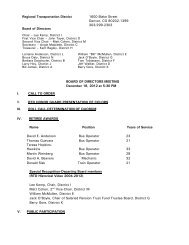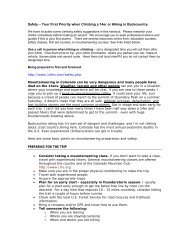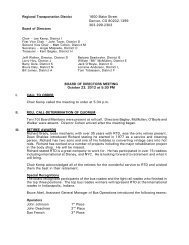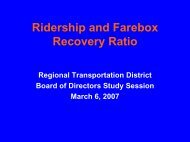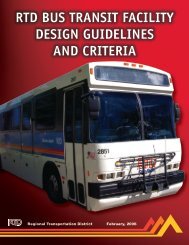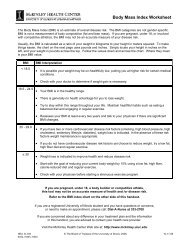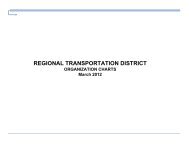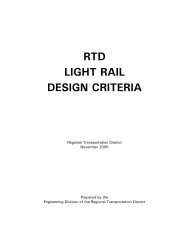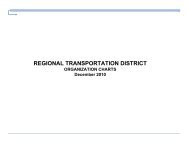Commuter Rail AC Electrification Load-Flow Simulation Report - RTD
Commuter Rail AC Electrification Load-Flow Simulation Report - RTD
Commuter Rail AC Electrification Load-Flow Simulation Report - RTD
You also want an ePaper? Increase the reach of your titles
YUMPU automatically turns print PDFs into web optimized ePapers that Google loves.
<strong>Commuter</strong> <strong>Rail</strong> <strong>AC</strong> <strong>Electrification</strong> <strong>Load</strong>-<strong>Flow</strong> <strong>Simulation</strong> <strong>Report</strong> Revision 1<br />
<strong>Load</strong> Factor<br />
• The load factor is defined as the ratio of average to peak power demand or current<br />
occurring in the same time interval. Because the traction load is highly fluctuating, the<br />
load factor of individual substations may be low where the train density is low.<br />
Messenger Wire<br />
• Upper wire in a catenary system from which the contact wire is suspended by means of<br />
hangers.<br />
Milepost<br />
• An identifier for a given location along a railroad line. Mileposts may or may not be<br />
located exactly one mile apart and may not be sequentially numbered.<br />
Multiple-Unit<br />
• A railroad car equipped with own propulsion system, braking system, and auxiliary<br />
devices.<br />
Non-Coincident Power Demand<br />
• Non-coincident power demand is a sum of the maximum power demands at system<br />
substations metered regardless of time of occurrence.<br />
Non-Conjunctive Billing<br />
• Non-conjunctive billing takes place when the maximum demand at each system substation<br />
is chosen for demand billing regardless of time of occurrence.<br />
Pantograph<br />
• Locomotive or EMU collector of traction power from overhead catenary system.<br />
Pantograph Head<br />
• Uppermost part of the pantograph fitted with the current collector which slides on the<br />
bottom of contact wire.<br />
Paralleling Station<br />
• Stations containing circuit breakers or switchgear line ups used for paralleling of traction<br />
power distribution system circuits. Catenary paralleling achieves better current sharing<br />
between the conductors, lowers the effective impedance between substations and trains,<br />
and results in lower voltage drop. In an autotransformer system the paralleling stations<br />
also parallel the feeders and contain autotransformer to transform the feeder/catenary<br />
voltage to catenary/rail voltage.<br />
02/27/2009 FRSC Page 42 of 250




